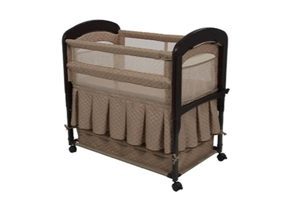
Bassinet Comes With Safety Concerns. Bassinets are growing in popularity with use almost doubling in the past ten years. Approximately 45 percent of parents use bassinets today for their babies younger than two months. Bassinets offer parents the convenience of sleeping in the same room as their infants without the danger of sharing the same bed. Unfortunately, […]

Bassinet Comes With Safety Concerns. Bassinets are growing in popularity with use almost doubling in the past ten years. Approximately 45 percent of parents use bassinets today for their babies younger than two months. Bassinets offer parents the convenience of sleeping in the same room as their infants without the danger of sharing the same bed. Unfortunately, a recent study is saying that bassinets come with their own significant safety concerns. Worse, while bassinets gain in popularity, there are no official government safety standards for this type of infant bed/carrier. All that is published are construction guidelines for manufacturers released by the Consumer Product Safety Commission (CPSC). The new study, which can be found in the current issue of The Journal of Pediatrics, evaluated bassinet use risk factors.
Researchers at the Children’s National Medical Center in Washington reviewed the death reports of 53 infants who died suddenly and unexpectedly in bassinets. In the vast majority of the cases—85 percent—researchers found that lack of oxygen was the cause of death. In over half of the cases studied, the infants were found on their stomachs; other items such as blankets, pillows, and even plastic bags were found in 74 percent of the bassinets. Nine infants died in bassinets that were not functioning properly with the malfunctions stemming from either “misuse” or mechanical problems. “If parents plan to use a bassinet, they should make sure that it is in good repair and conforms to CPSC guidelines,” say the authors of the bassinet study.
The CPSC guidelines call for bassinets to have a sturdy bottom with a wide base; smooth surfaces without protruding hardware; legs with locks; and a firm, snug-fitting mattress. Six of the 53 infants who died in bassinet accidents were found with their faces wedged against the side of the bassinet. Because of this, the authors of the study suggest that a bassinet with sides made of an air-permeable material, such as mesh, may be a safer alternative. The authors also stress that parents should always lay infants on their backs and never put loose items like blankets or pillows in the bassinet with the baby.
When shopping for a bassinet, ensure the item has a sticker that indicates the furniture has received certification from the Juvenile Products Manufacturers Association (JPMA). While a JPMA certification is not a guarantee of safety, it is today’s best assurance to consumers that the bassinet meets the voluntary safety standards set by the American Society for Testing and Materials International (ASTM). Unfortunately, the standards are voluntary and bassinet manufacturers are not required to conform to such standards.
Meanwhile, last month, a crib recall of 320,000 cribs was initiated over flimsy wood that posed entrapment and strangulation risks to infants. The shoddy cribs made it into stores because there is no US regulatory standard that mandates what type of wood be used in cribs. This is not the first time cribs have experienced wide-scale recalls over similar problems.
The personal injury attorneys at Parker Waichman LLP offer free, no-obligation case evaluations. For more information, fill out our online contact form or call 1-800-YOURLAWYER (1-800-968-7529).


